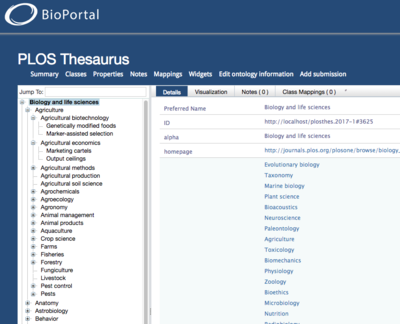Difference between revisions of "SKOSSupport"
m |
|||
| Line 24: | Line 24: | ||
<nowiki><http://www.example.com/animals></nowiki> rdf:type skos:Concept | <nowiki><http://www.example.com/animals></nowiki> rdf:type skos:Concept | ||
| − | In SKOS vocabularies, BioPortal only treats the SKOS | + | In SKOS vocabularies, BioPortal only treats the SKOS concept assertions as concepts to be displayed. If the vocabulary contains other assertions about other types of concepts, BioPortal will not treat these as concepts in any of its displays or features. See the W3C's SKOS System Primer and SKOS Reference for concept documentation and examples: |
https://www.w3.org/TR/2009/NOTE-skos-primer-20090818/#secconcept | https://www.w3.org/TR/2009/NOTE-skos-primer-20090818/#secconcept | ||
Revision as of 11:48, 1 December 2017
Support for SKOS vocabularies in BioPortal
BioPortal is a web-based portal for accessing and sharing ontologies. The application accepts ontology submissions in OWL and OBO format, and SKOS vocabularies that contain particular constructs.
This wiki page documents the minimum set of SKOS constructs that must be present in a SKOS vocabulary for BioPortal to accept and handle the submission properly.
Please note that the SKOS constructs described here are handled only for vocabularies that are identified as SKOS when they are submitted to BioPortal. Vocabularies submitted as OWL or OBO formats are not examined for SKOS constructs.
Required SKOS constructs
skos:Concept
Concepts are the fundamental elements of SKOS vocabularies and are asserted using the skos:Concept class, e.g.:
<http://www.example.com/animals> rdf:type skos:Concept
In SKOS vocabularies, BioPortal only treats the SKOS concept assertions as concepts to be displayed. If the vocabulary contains other assertions about other types of concepts, BioPortal will not treat these as concepts in any of its displays or features. See the W3C's SKOS System Primer and SKOS Reference for concept documentation and examples:
https://www.w3.org/TR/2009/NOTE-skos-primer-20090818/#secconcept
https://www.w3.org/TR/skos-reference/#concepts
skos:ConceptScheme & skos:hasTopConcept
For every ontology entry in BioPortal, the application provides a tabbed interface with various views of the ontology data, e.g., a "Classes" tab with a tree structure to graphically depict the hierarchical collection of ontology classes.
In the case of SKOS vocabularies, BioPortal determines which concepts to display as roots in the concept tree by querying vocabulary content for occurrences of skos:hasTopConcept property assertions. Top concepts are the most general concepts contained in SKOS concept schemes (an aggregation of one or more SKOS concepts).
The following example, taken from the SKOS System Primer, shows how to define a concept scheme and link it to the most general concepts it contains:
@prefix skos: <http://www.w3.org/2004/02/skos/core#> . @prefix rdf: <http://www.w3.org/1999/02/22-rdf-syntax-ns#> . @prefix ex: <http://www.example.com/> . ex:animalThesaurus rdf:type skos:ConceptScheme; skos:hasTopConcept ex:mammals; skos:hasTopConcept ex:fish.
SKOS vocabularies submitted to BioPortal must contain a minimum of one concept scheme and top concept assertion. See the the SKOS System Primer and SKOS Reference for more documentation of concept schemes and top concepts:
https://www.w3.org/TR/2009/NOTE-skos-primer-20090818/#secscheme
